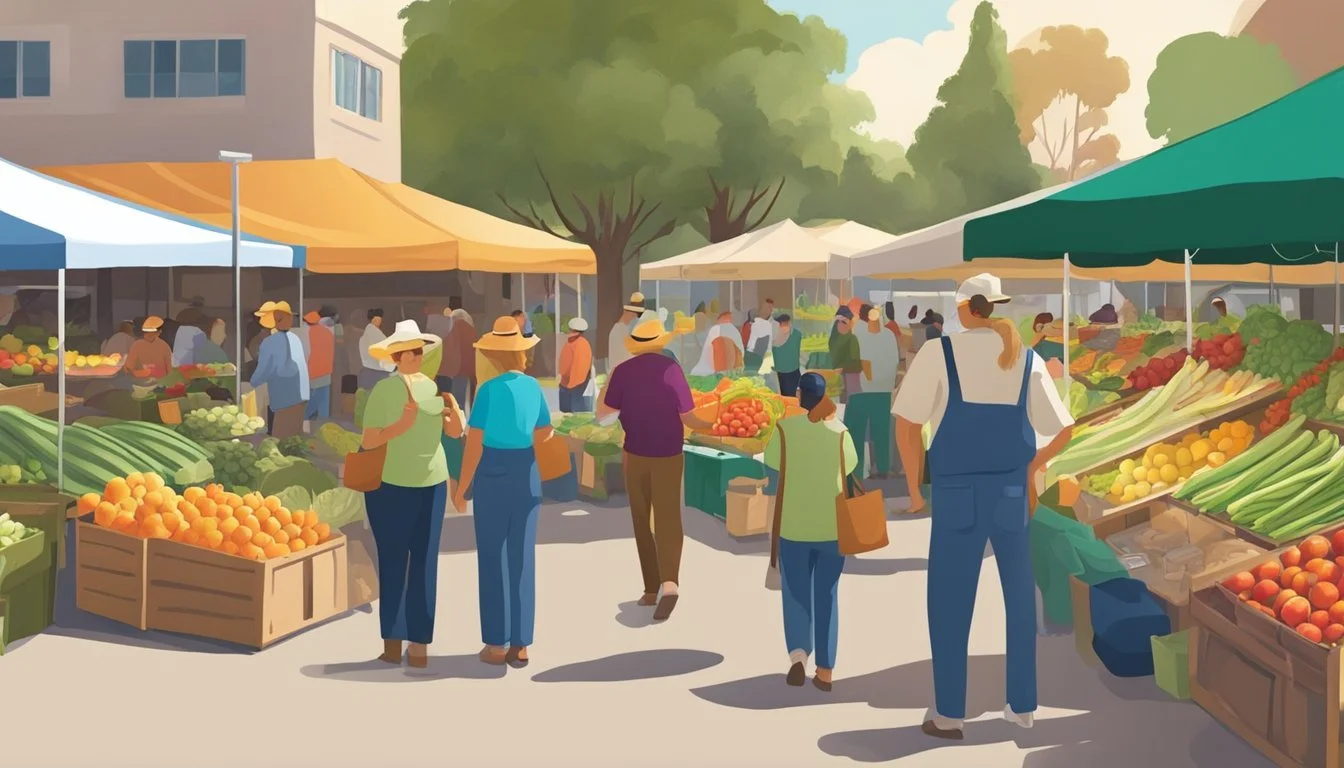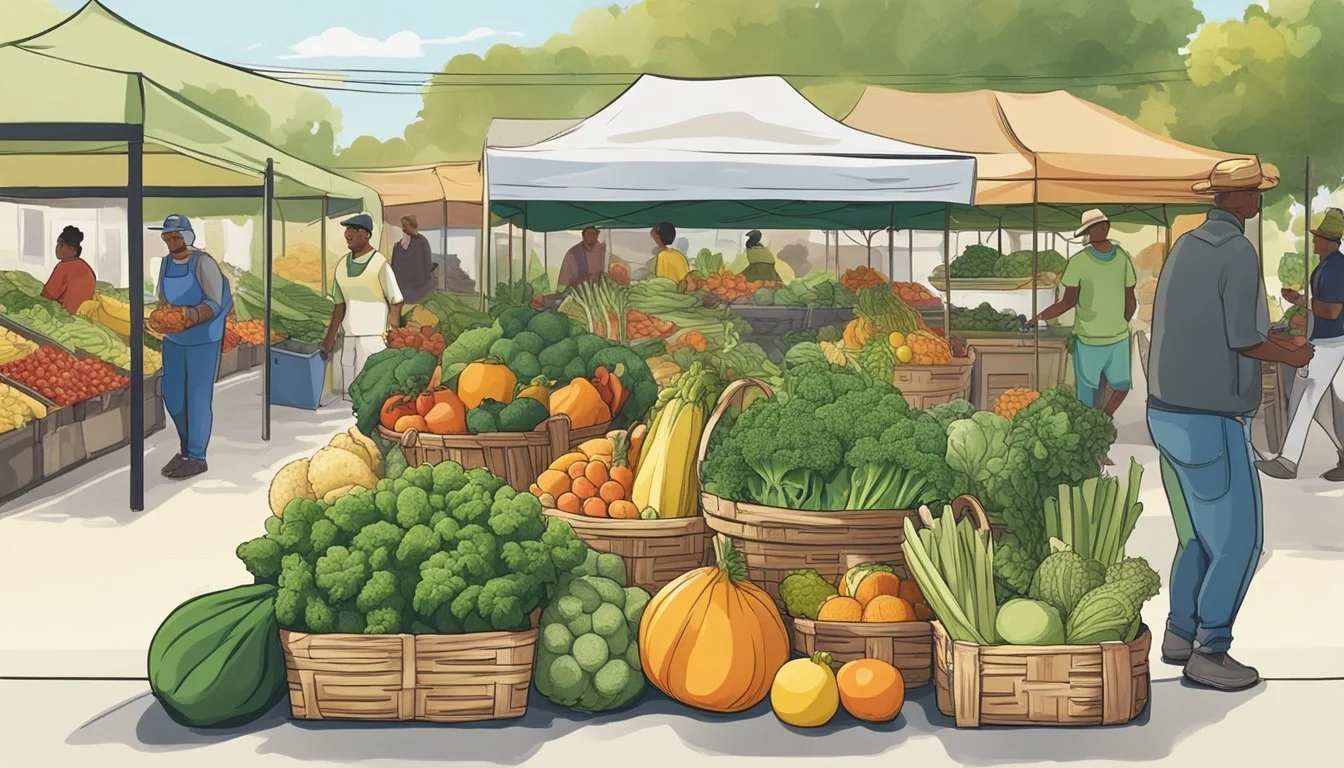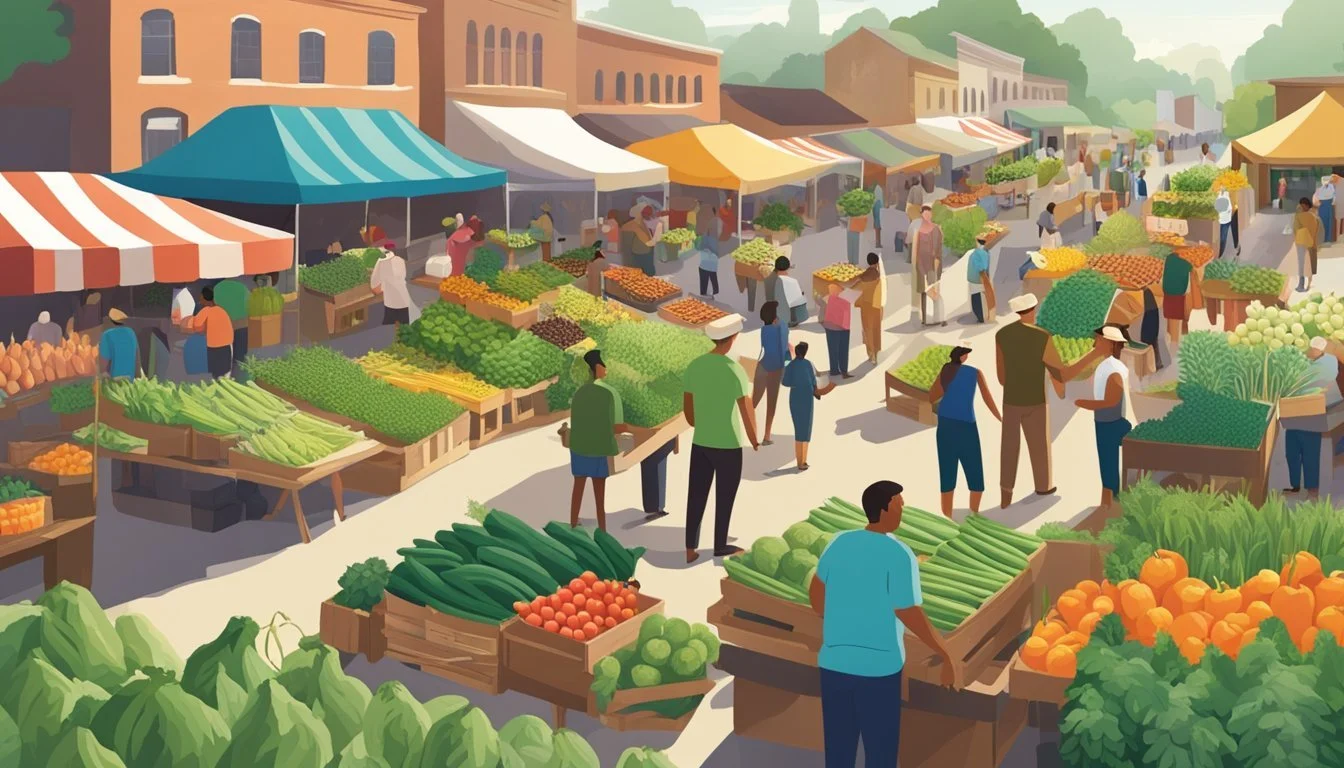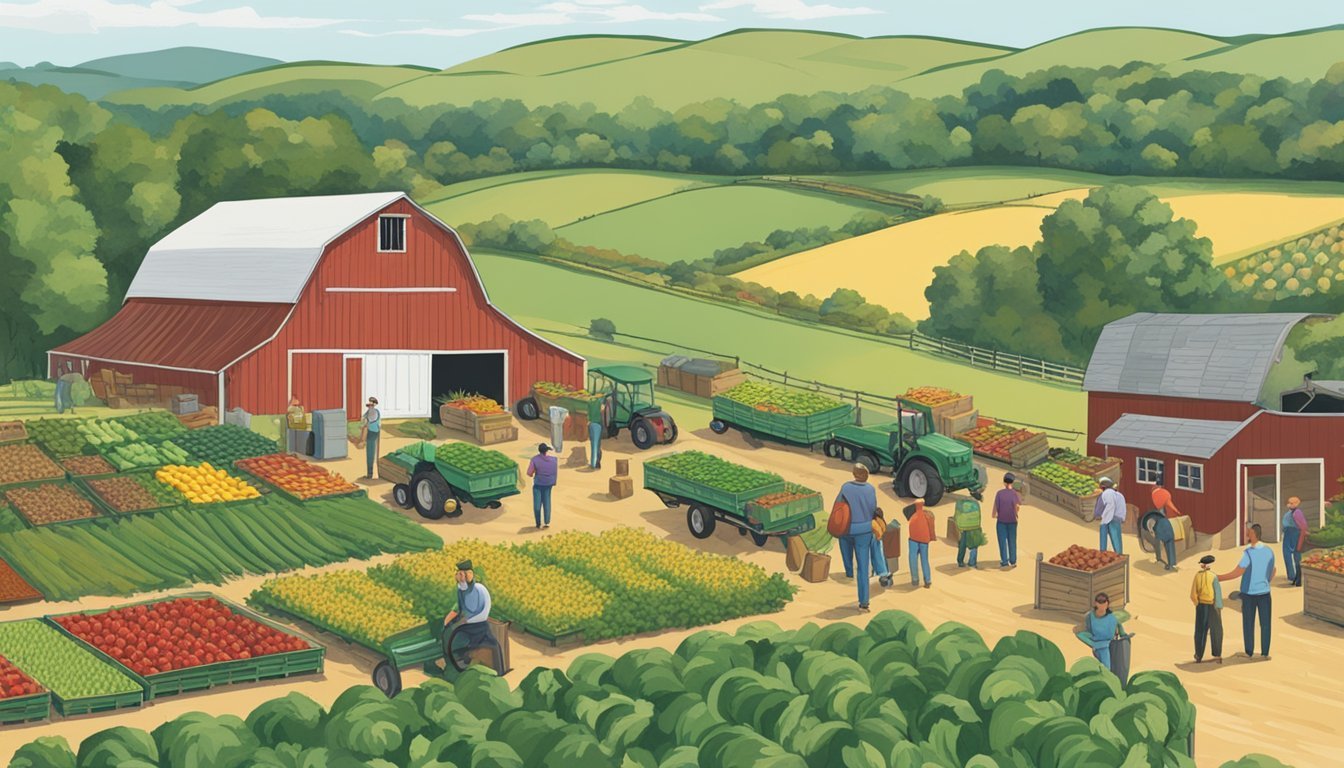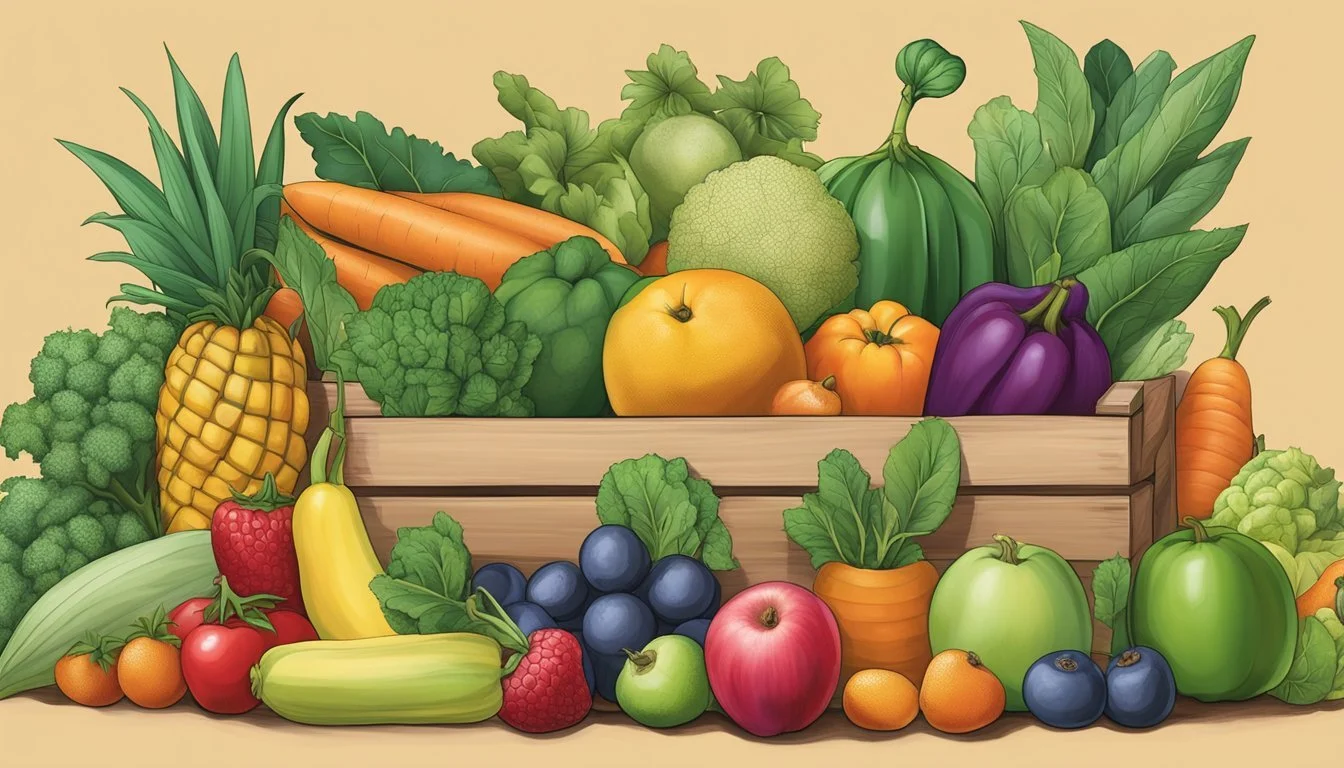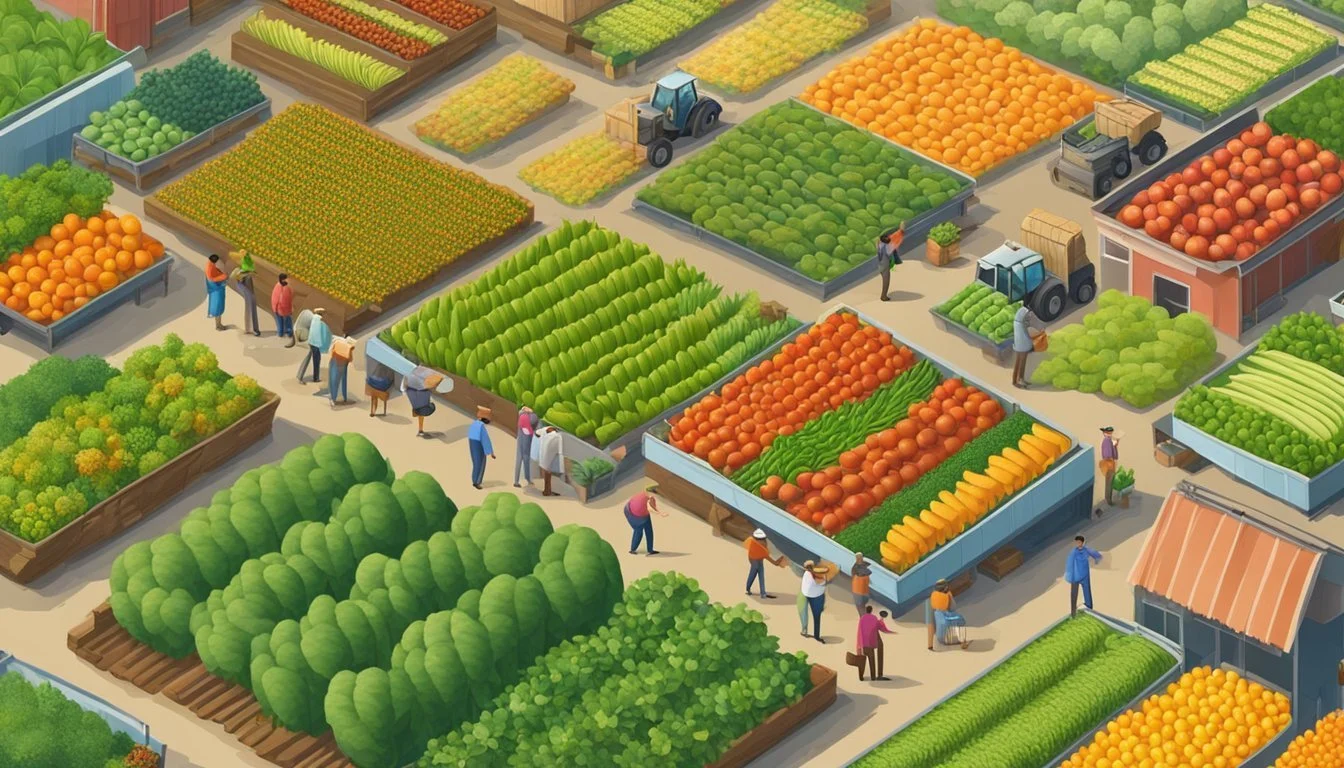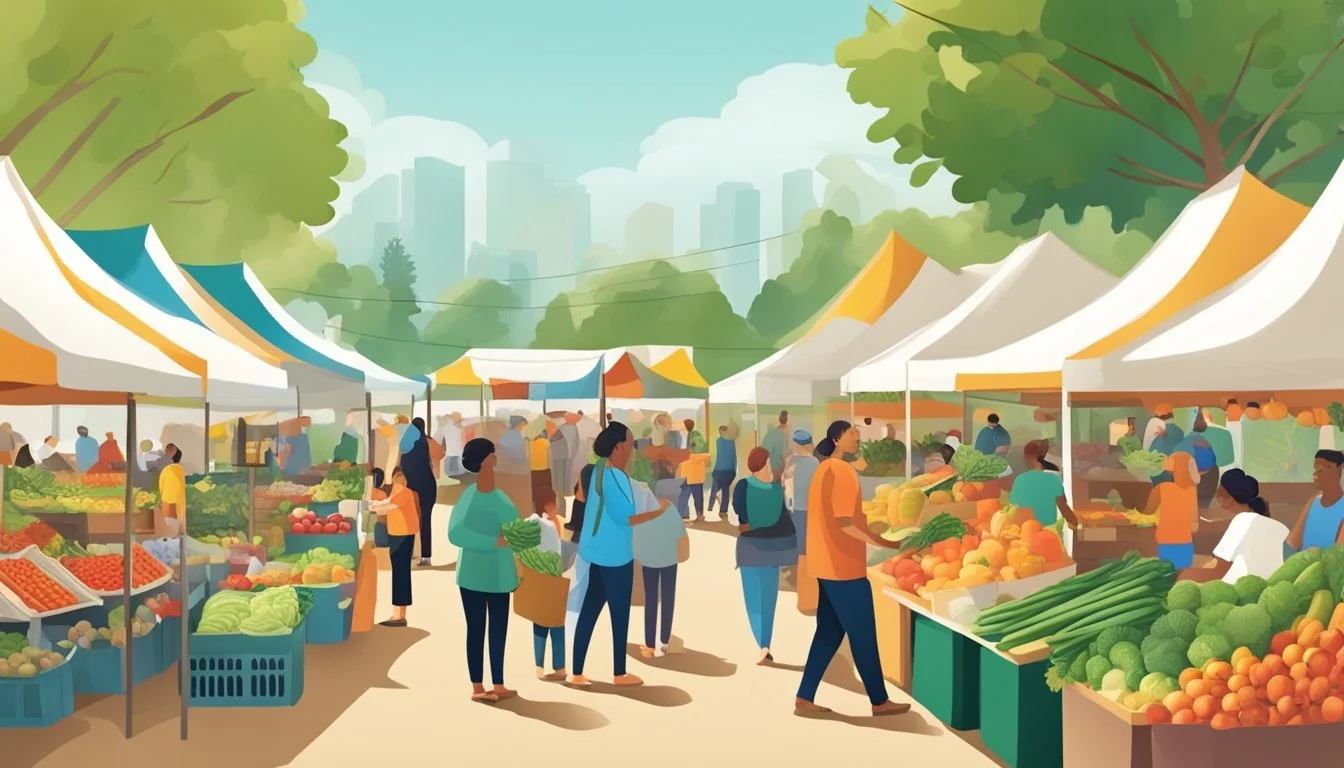Community Supported Agriculture (CSA) in Ontario, CA
A Guide to Local Farm Partnerships
Community Supported Agriculture (CSA) represents a collaborative approach to farming and food distribution that connects the residents of Ontario, California with fresh, locally-grown produce. This system is grounded in the partnership between consumers and their local farms, whereby individuals can purchase "shares" from area farmers. In return, they receive a portion of the farm's harvest throughout the season, often in the form of a weekly box of assorted fruits, vegetables, and sometimes other farm products.
In Ontario, CA, this model serves as a vital link between consumers and the agricultural community. It not only sustains farmers by providing them with upfront revenue and financial security but also offers community members access to nutritious, organic food. Thanks to a number of certified organic farms that have banded together, Ontario residents have the opportunity to experience a diverse array of produce, all sourced within their regional foodshed.
The CSA model in Ontario nurtures a deeper understanding and appreciation for local agriculture. It promotes economic stability for farmers who practice traditional family farming, and fosters an environment where the community can engage with those who grow their food. This agricultural framework not only bolsters local economies but also supports sustainable farming practices and enhances food security within the region.
The Basics of Community Supported Agriculture
Community Supported Agriculture (CSA) involves individuals who pledge support to a farm operation so that the farmland becomes, either legally or spiritually, the community's farm. Members benefit from receiving fresh food throughout the season as well as deepening their connection to the land and the food production process.
CSA Program Structure
In a typical CSA program, members buy a share of the harvest in advance, which provides the farmer with the necessary capital at the start of the growing season. This share entitles the member to a weekly or bi-weekly delivery of produce or farm products. The structure of a CSA membership is outlined as follows:
Purchase of Shares: Members pay an upfront fee before planting begins.
Regular Distributions: The farm provides products to members at set intervals, usually weekly.
Seasonal Variability: The contents of a CSA share vary with the season's harvest.
Benefits of Joining a CSA
Members who join a CSA enjoy several advantages:
Health and Nutrition: Access to a variety of fresh, locally grown produce.
Supporting Local Food Systems: By participating in a CSA, members bolster the local economy and contribute to sustainable food systems.
Direct Farmer Relationship: Members often have opportunities to visit the farm and meet the people responsible for growing their food.
Getting Started with CSA in Ontario
Community Supported Agriculture (CSA) programs in Ontario provide residents with a direct pipeline to high-quality, locally-grown produce. They ensure economic stability for farmers and contribute to sustainable agricultural practices.
How to Sign Up for a CSA
When individuals decide to sign up for a CSA in Ontario, they typically begin by visiting a website dedicated to connecting farmers and consumers, such as LocalHarvest. The process is as follows:
Search: Use LocalHarvest to find available CSA programs by entering the Ontario area as the search location.
Contact: Reach out to the CSA farm of choice directly through the contact information provided.
Register: Complete the CSA registration, which usually includes selecting a share type and payment details.
Table: Basic Steps to Sign Up
Step Action 1 Search for CSAs in Ontario on LocalHarvest 2 Contact chosen CSA farm 3 Register for your share
It is essential to ask questions regarding share sizes, pick-up logistics, and what types of produce to expect during the season. This information aids in setting clear expectations and ensures a satisfactory CSA experience.
Choosing the Right CSA
Selecting the right CSA is crucial to match individual needs and preferences. Here are key considerations:
Type of Produce: Some CSA farms focus on a wide variety of vegetables, while others may include fruits, herbs, eggs, or meat.
Organic Practices: Inquire about the farming practices to ensure they align with personal preferences for organic or sustainable agriculture.
Pick-Up Location: Ensure the farm's pick-up location or drop-off points are convenient. Some farms offer delivery services, which can be a deciding factor.
Community Involvement: Farms may offer different levels of engagement, from newsletters and community events to opportunities to help on the farm.
A well-informed choice is built on understanding the CSA's offerings and how they align with the potential member's lifestyle and values.
Organic Practices and Ecological Impact
Community Supported Agriculture (CSA) in Ontario, CA champions organic practices to ensure a positive ecological impact. The focus is on fostering sustainability in agriculture with adherence to strict organic produce certification.
Sustainable Agriculture Principles
CSAs in Ontario are dedicated to sustainable agriculture principles. They implement practices such as crop rotation, use of natural pest controls, and conservation tillage. These methods support the health of the soil and ecosystems, thereby ensuring long-term agricultural productivity.
Crop Rotation: Enhances soil nutrients and breaks pest and disease cycles.
Natural Pest Controls: Utilizes beneficial insects and plants to manage pests without synthetic chemicals.
Conservation Tillage: Reduces erosion and soil compaction, preserving soil structure and biodiversity.
Organic Produce Certification
Organic produce certification is a rigorous process that Ontario's CSA farms undergo to validate their adherence to organic standards. Certification ensures that:
Synthetic Inputs: No synthetic pesticides or fertilizers are used.
GMOs: Genetically modified organisms are not present in the production.
Soil Management: Soil health is maintained through organic practices detailed in the certification guidelines.
Farmers maintain detailed records and are subject to regular inspections to uphold certification standards, assuring consumers of the organic integrity of their produce.
Local Food Systems and Communities
Community Supported Agriculture in Ontario, Canada, epitomizes the intertwining of local food systems with the strength of community networks. By facilitating direct interactions between consumers and producers, CSA nurtures a localized, efficient, and sustainable food economy.
Building a Sense of Community
In Ontario, Community Supported Agriculture establishes substantial relationships between community members. It is these connections, forged through a shared commitment to local food distribution, that cultivate a sense of belonging and mutual support. In essence, a CSA serves as a communal food hub, notably at farmers markets, embodying a space where individuals converge, not just to purchase fresh produce but also to engage in a vibrant, community-centric atmosphere.
Supporting Local Farmers
Commitment to CSA translates into robust support for local farmers. By subscribing to seasonal harvest shares, community members provide a stable financial base that enables farmers to sustain and grow their operations. This model minimizes the uncertainty often associated with farming, allowing for a concentration on producing high-quality, non-certified organic vegetables and other crops. In turn, farmers in Ontario are empowered to maintain local soils and contribute to the provision of safe, fresh, and healthy food, ensuring the longevity of local food systems.
Understanding CSA Shares
Community Supported Agriculture (CSA) in Ontario enables consumers to purchase a "share" of the harvest directly from local farms. This concept supports farmers while providing shareholders with fresh, organic, and seasonal produce throughout the farming season.
What's Included in a Share
Each CSA share typically includes a weekly or bi-weekly box of fresh vegetables and fruits. The contents vary and may depend on the CSA model chosen by the subscribers. Some farms offer flexibility allowing shareholders to select from the available produce, while traditional models provide a farmer's choice selection. Beyond produce, many CSAs offer the option to include other farm products such as:
Eggs: Commonly, a dozen fresh eggs per week.
Meat: A selection of locally raised, often grass-fed or organic meat.
Additional Shares: Depending on the farm, other items like microgreens or honey may be available.
Seasonal Produce Varieties
CSAs provide an array of seasonal produce, which often includes but is not limited to:
Spring: Greens, radishes, asparagus, and rhubarb.
Summer: Tomatoes, peppers, cucumbers, and berries.
Fall: Squashes, apples, root vegetables, and pumpkins.
The produce offered generally reflects what is abundant and at peak readiness for harvest at different times of the year. This approach ensures that the shareholders receive the freshest possible fruits and veggies while supporting the farm's crop rotation and sustainable practices.
CSA Membership and Consumer Responsibility
When individuals join a Community Supported Agriculture program in Ontario, they engage in a mutual commitment with local farms. Members agree to share some of the inherent risks of agriculture while gaining access to fresh, organic produce directly from their community's farmers.
Member Commitments and Responsibilities
Members of a CSA agree to support their chosen farm financially by purchasing a share at the beginning of the growing season. This commitment provides the farm with a stable income to cover the anticipated costs of production. In return, CSA members typically receive weekly boxes of fresh, seasonal produce. Responsibilities of CSA members also include understanding the following:
Pick-up: Members must adhere to the specified pick-up schedule and locations.
Flexibility: Harvest can vary, so members should be prepared for fluctuations in the variety and quantity of produce received.
Communication: Members should maintain open communication with their CSA farm regarding any concerns or questions.
Risks and Rewards of CSA Membership
CSA membership is built on the premise of shared risk and reward between the farmer and consumer. The risks for members mainly involve agricultural uncertainties that could affect their share, such as adverse weather or pest problems. However, the rewards often outweigh these potential risks:
Quality: Access to high-quality, fresh produce often picked the same day it's provided to members.
Supporting Local: Consumers investing in a CSA are sustaining local agriculture and contributing to a healthier food system.
Engagement: CSA members frequently have opportunities for greater engagement with the farming process, like events or volunteer possibilities.
Being a CSA member requires integrating these elements into their consumption practices, which both supports their local economy and fosters a deeper food awareness.
From Farms to Tables
Community Supported Agriculture in Ontario connects local farmers directly with the community, ensuring a supply of fresh, local food through a mutually supportive framework. This process is integral to maintaining the province's agricultural vitality and ensuring that residents have access to seasonal, locally-grown produce.
The Harvesting Process
Farmers in Ontario's CSA programs meticulously tend to their crops, ensuring that the harvest reflects a commitment to quality and sustainability. When the produce reaches peak maturity, it is harvested with great care, maintaining its nutritional value and freshness. Harvest times can vary, governed by seasonal changes and specific crop characteristics.
Spring: Leafy greens, radishes, and herbs
Summer: Tomatoes, peppers, cucumbers, and berries
Fall: Squashes, root vegetables, and apples
Distribution and Delivery Methods
Once harvested, the produce is swiftly allocated to shares for members of the CSA program. Distribution methods are designed for convenience and maintaining the quality of produce.
Pick-up Points: Designated local spots such as farmers markets or central community locations
Farm Pick-up: Directly from the farm, where members can often engage with their farmers
Home Delivery: Limited to certain farms, offering direct to doorstep service for a personalized touch
Farmers employ a variety of delivery methods depending on the size of their operation and the needs of the community. They aim to reduce time from farm to table, maximize produce freshness, and foster a connection between consumers and their food source.
Health and Nutrition Aspects of CSA
Community Supported Agriculture (CSA) programs in Ontario, Canada, are pivotal in enhancing the availability of nutritious food while supporting local agriculture. These programs provide a direct link between local farmers and consumers, promoting health through access to fresh, organic produce.
Access to Healthy Food
Ontario's CSA programs facilitate consumers' access to a variety of fresh, locally-grown produce. In doing so, they play a significant role in improving dietary choices among community members. The model ensures a steady supply of seasonal fruits and vegetables, which are often picked at their peak freshness, thereby retaining more nutrients than produce that has traveled long distances.
Increased Availability: CSA members receive regular shares of produce, ensuring consistent access to healthy foods.
Local Variety: CSAs often offer a wider array of produce types, some of which might not be readily available at local supermarkets.
Nutritional Benefits of Organic Produce
Organic produce is a staple of many CSA programs in Ontario. Such produce is grown without synthetic pesticides or genetically modified organisms (GMOs), contributing to both environmental health and potentially better human health outcomes.
Lower Contaminant Levels: Organic produce typically contains lower levels of pesticides and other contaminants.
Higher Nutrient Profiles: Some studies suggest that organic produce can have higher levels of certain nutrients, such as antioxidants.
CSAs are instrumental in promoting nutritious eating habits and supporting sustainable farming practices that contribute to the overall health of the community. Through the provision of fresh, organic options, CSA members can enjoy the numerous health benefits associated with a diet rich in fruits and vegetables.
Economic Aspects and CSA Management
In Ontario, Community Supported Agriculture (CSA) programs are a critical interface between consumers and sustainable local food systems, with an intricate balance of financial planning and organizational structure profoundly influencing their success.
CSA Financial Planning
Economic sustainability for a CSA begins with robust financial planning. Producers must account for costs involved in crop production, labor, marketing, and delivery. Cash flow management is central to stability as upfront payments from members are often used to cover initial production expenses. Producers must craft a detailed plan to ensure a consistent supply to members throughout the season, managing both surpluses and shortages efficiently.
Break-even Analysis: Calculation of the point at which revenues equal costs.
Budgeting: Estimating precise income and expenditure for the season.
Risk Management:
Diversification of crops to mitigate the impact of crop failure.
Offering different levels of share commitments to consumers.
Non-Profit Organizations and CSA
Non-profit organizations often facilitate CSA programs to support their community-oriented missions. Such organizations utilize CSA to promote local agriculture, food security, and economic development while connecting consumers directly with the source of their food. They often reinvest any surplus funds into the program or community projects, differentiating them from for-profit models.
Funding: They may access grants and donations, alleviating initial financial stress.
Community Engagement: Increased by offering educational programs and volunteering opportunities.
Non-profits may also act as intermediaries, managing CSA logistics and helping with member recruitment and retention, contributing to the CSA program's overall resilience and sustainability.
Questions and Research
This section emphasizes the common inquiries from consumers interested in CSA programs and the latest studies and advancements within the CSA innovation networks.
Consumer Inquiries
Consumers often exhibit a heightened interest in understanding what subscribing to a CSA entails. Key questions they frequently ask include:
What does membership in a CSA involve?
How does one's investment support local agriculture?
What are the risks and benefits associated with CSA subscriptions?
Answers to these inquiries shed light on the structure and community engagement aspect of CSA, where members share in both the bounty and risks of agricultural seasons.
Ongoing CSA Research and Innovations
Research in the CSA domain is dynamic, focusing on both improvement of operations and enhancing the consumer-producer relationship. Current research areas include:
Member retention: Investigating factors that influence continued participation.
Sustainable practices: Exploring effective organic farming techniques.
Innovations within CSA networks aim to refine these models based on insights gleaned from comprehensive data analysis and community feedback.
CSA innovation networks often collaboratively explore:
Best methods to distribute organic produce efficiently.
Techniques for engaging more community members.
Financial models that sustain farms and satisfy consumers.
Research outcomes have the potential to significantly benefit the CSA model by addressing consumer questions and improving the agricultural process and community involvement.
Connecting with CSA Networks
In Ontario, CA, individuals interested in joining a Community Supported Agriculture network can leverage various resources and platforms to locate CSAs and engage in the local food system effectively.
Finding a CSA Near You
Residents of Ontario, CA seeking to participate in CSA programs have several avenues to explore. A primary resource is LocalHarvest, a comprehensive online directory that provides detailed information on CSAs, as well as farmers' markets and other local food sources. Individuals can use LocalHarvest to search for nearby CSA farms by entering their city or postal code. Here's a straightforward approach:
Visit the LocalHarvest website.
Enter "Ontario, CA" into the search bar.
Filter the results by selecting the CSA category.
This search will yield a list of CSA programs operating within the Ontario area, complete with contact details and sign-up options.
The Role of Online Platforms in CSA
Online platforms are integral in connecting consumers with CSA networks. They serve as virtual meeting points where producers can list their offerings, and consumers can find and subscribe to CSA shares. The CSA Innovation Network is an example of such a platform that supports CSA development by serving as a centralized hub for sharing tools and programs beneficial to both CSA providers and consumers. Online platforms often feature interactive elements such as reviews and forums that help consumers make informed decisions. Moreover, online payment and subscription management tools have simplified the process of securing and maintaining CSA shares.
Frequently Asked Questions
Community Supported Agriculture (CSA) programs in Ontario provide fresh, local farm products to community members. This section addresses common queries and provides practical advice for navigating CSA membership.
Tips for New CSA Members
Preparing for Your Share:
Research: Understand what produce is seasonally available in Ontario to set realistic expectations for your share.
Storage: Learn proper storage techniques for a variety of produce to ensure longevity and freshness.
Maximizing Benefits:
Meal Planning: Plan meals around your CSA share to fully utilize all the produce and reduce food waste.
Community Involvement: Engage with your farmer and fellow CSA members to share recipes, tips, and experiences.
Common Concerns with CSA Participation
Selection of Produce:
Variety: Some members worry about the limited choice in the types of produce received. It is a part of the CSA experience to try new foods and embrace seasonal eating.
Commitment:
Share Size: The commitment to a season's worth of produce can be daunting. Some farms offer half-shares or flexible plans to accommodate different household sizes and needs.
Payment:
Cost: Questions about the upfront cost are common. Payment supports the farmer's season and often compares favorably to purchasing equivalent organic produce at market prices. Some CSAs offer installment plans to ease the financial burden.
Animals in CSA
Community Supported Agriculture farms in Ontario, CA intertwine crop growing with animal rearing, providing a symbiotic environment where each element supports the other. Animals, particularly hens and livestock, play a crucial role on CSA farms.
Role of Hens and Eggs in CSA
Hens are a vital part of many CSA operations. They contribute to the farm's ecosystem by providing natural pest control and fertilizing the soil with their droppings. In return, they produce eggs that are often included in CSA shares. These eggs are known for their freshness and high quality, having come from hens that usually enjoy free-range living conditions, access to a variety of natural foods, and overall healthier lifestyles.
Egg Contribution: Freshness and Nutritional Value
Hens' Contribution: Pest Control and Soil Fertility
Meat Shares and Animal Welfare
Meat shares in CSA programs typically involve a subscription to receive a portion of pasture-raised meat from animals such as cows, pigs, and chickens. Farmers focusing on animal welfare adhere to ethical practices that ensure the well-being of these animals. This includes providing spacious living conditions, proper veterinary care, and a natural diet. Meat from CSA programs is touted for its sustainable nature and quality flavor.
Meat Types: Chicken, Pork, Beef
Ethical Considerations:
Spacious Living Conditions
Natural Diet
Regular Veterinary Care

